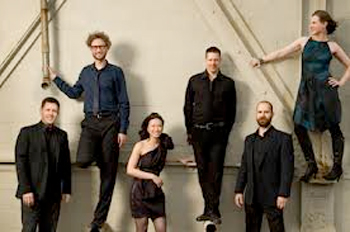by Mike Telin

Premieres by Oberlin faculty members Tom Lopez and Peter Swendsen bookended the concert. Each work is scored for two identical groups of instruments — flute, clarinet, violin, cello, piano and percussion plus electronics. Both were given inspired performances by eighth blackbird and CME.
Lopez’s Skipping Stones (2013) is an evocative work reminiscent of tossing rocks into the water while floating down a placid river — an effect achieved through the tossing of musical motives from one group of six to the other. Lopez creates a multi-hued sound palette through the use of Gershwin-like clarinet slides, whistles, kazoos, waterphone and electronic echoes. Lopez also makes effective use of silence.
Swendsen’s relentlessly rhythmic Six Ways through a Glass of Absinthe (2013) is inspired by Picasso’s 1911 painting of the same name. Throughout, Swendsen cleverly derives pitch material from Stravinsky’s Petrushka chord, a 1911 French popular song, and a spectral analysis of two glasses stuck together and resonating. Field recordings made by the composer include bells from the Palais Garnier lobby, a carousel near the Eiffel tower and a café in Versailles, which accented the work’s early twentieth century Paris inspiration.
CME director Timothy Weiss led CME in a captivating premiere of Benjamin Broening’s What the Light Was Like (2013), a work in five titled movements. Atmospheric celestial twinkles embody mourning cloaks while fogbound shroud is brought to life through repeated bass notes and miasmal wind solos. Repeated treble notes and nervous percussive jangles create perfect imagery for cathedral train of blinking, and light on water rippled with lyricism. Dark and brooding, the charring iridescence of his last perception brings the piece to an ominous conclusion with a muted off-stage trumpet crying out in pain.
A highlight of the evening was the first movement, marked “Driving, relentless,” from Derek Bermel’s Tied Shifts. (2004). Written for the ensemble, the work is quintessential eight blackbird — who perform from memory and never miss an opportunity to punctuate a musical point through the use of carefully planned choreography. And for five fast and furious minutes, flutist Tim Munro, clarinetist Michael Maccaferri, violinist/violist Yvonne Lam, cellist Nicholas Photinos, percussionist Matthew Duvall and pianist Lisa Kaplan tossed off even the most difficult, fast moving, rhythmically complex lines with aplomb.
In the program notes, Lisa Kaplan writes: Whirligig for piano four hands (2013) “is all about getting up in each other’s business and relishing it.” Although Kaplan wrote the piece for herself and composer Nico Muhly, at this concert each movement was performed with a different partner.
Off-kilter (Yvonne Lam) is a jazzy toccata with a treble interlude which ends with each player fighting for space in the piano’s highest register. Merry go round (Matthew Duvall) indeed takes us on a lyrical carousel ride on a sunny Sunday afternoon. Boogie-Woogie (Sanford Margolis, Kaplan’s teacher at Oberlin) is simply a hoot complete with driving bass lines and pounding chord clusters produced by the performers’ forearms.
Rounding out the program, cellist Nicholas Photinos was a commanding soloist during Kaija Saariaho’s Amers (1992). Written in two movements played without pause, the piece is a thickly-textured work centering around the low e-flat “vertical trill” (alternating between normal sounds and harmonics). Saariaho creates colorful sound clouds in the accompanying ensemble of winds, harp, percussion, electronic keyboards and electronic tape. Conductor Weiss and the CME were alert and sympathetic collaborators.
Published on ClevelandClassical.com October 15, 2013
Click here for a printable version of this article.



